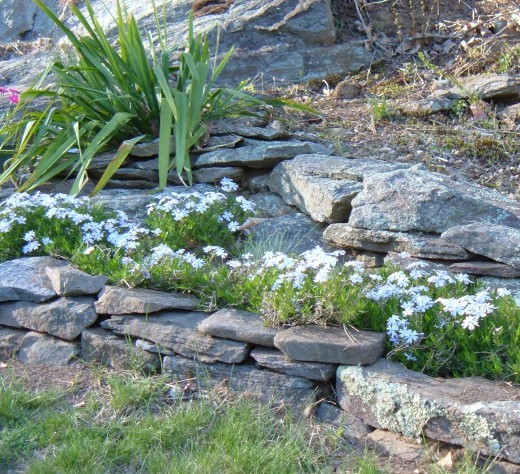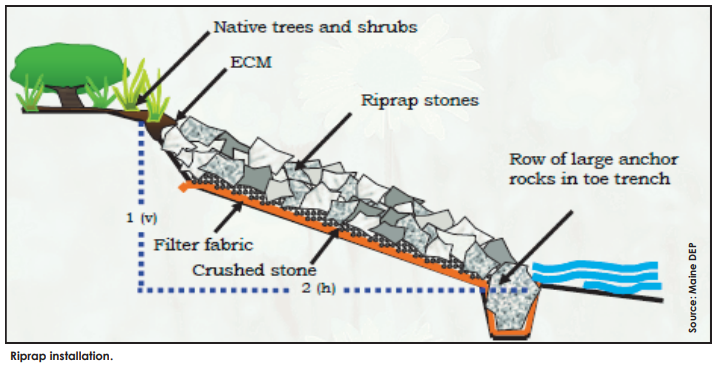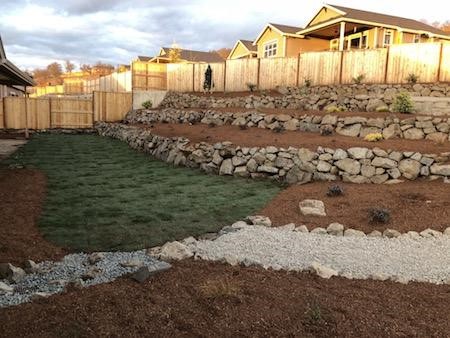When we lose 24 billion tonnes of fertile soil every year due to erosion, we also lose the opportunity for soils to feature as a prominent climate change solution. Soils store more than 4,000 billion tonnes of carbon, which means it’s a viable solution for reducing global carbon woes.
Zoom in from this global picture to your slice of the land: There are a range of erosion control methods you can implement in your backyard and on your property.
Rock use and placement is a particularly innovative solution because it allows homeowners to blend function and aesthetics.
Erosion control is especially crucial if your home sits on a slope or your property area is hilly. Gravity isn’t doing you any favors — and harsh summer months with sudden rainfalls can drain soils of their nutrients and strangle plant life.
In these cases, rocks provide the best natural solution because you’re keeping well-established soil from draining or being blown away. Keep reading to learn how to place rocks on a slope to stop erosion.
Types Of Rocks To Help Stop Erosion
Strategic rock placement can help you maintain the positive, restorative effects of other erosion control methods by keeping soil protected from events like flash floods, high winds, and harsh, extreme sunlight.
Keep in mind that using rocks as a solution for erosion control on slopes works best when your vegetation is already well-established and your soil nutrient levels are thriving. If you need to bring your soil’s fertility levels back up, erosion control blankets are a better choice.
Your choice of the right rock type for your property depends on its physical orientation, and there are multiple options, each with a specific purpose.
1) Cobblestones
You may think cobblestone exists to make driveways and streets more aesthetically pleasing, but this type of stone has its use in erosion control. Its round-edged, interlocking configuration makes it the ideal rock type for allowing a natural stream of water, nutrients, and root systems to move through the soil unobstructed.
Engineers and landscapers tasked with using this type of stone on a sloped property may also use cobblestone as a filler material for a structure called a “gabion.” These are baskets or crib-like arrangements used in retaining walls or dams which allow the soil to breathe but constrict potential soil dislodging or movement.
2) Gravel
Gravel used for erosion control comes from mines and quarries. These small but sturdy rock types are for layering and holding soil in place, just like mulch would be used to hold a new tree in place.
To be used as soil erosion control, the gravel needs to be hewn from natural stone that is porous such as sandstone because this allows water to soak through the tiny capillaries within the rock and get to the soil. Gravel from natural, porous rock gives the soil heft and weight it needs while still allowing water to filter through easily.
3) Non-Absorbent Stone
Most natural stones and rock types are absorbent because they’re porous and allow liquids to sink through. Non-absorbent stone might seem counterintuitive in this light, but it has its use.
A material like clay or certain types of granite with lower porosity don’t work well within the soil, but they do make ideal materials for support terraces or retaining walls.
4) Riprap
Riprap are large, irregular-shaped rocks that lock into place without any mortar. They’re typically used in situations where the shoreline on a pond, stream, or river bank is severely eroding.
Riprap stones can also help to set re-sloped areas in place, especially when used in combination with filter fabric, such as an erosion control blanket.
Resloping your sloped areas with riprap is especially useful if you’re trying to re-establish vegetation, smooth out erosion gullies, and trap eroding soil more effectively and naturally.
Four Reliable Methods Of Erosion Control With Rocks On A Slope
Once you choose the right type of erosion control rocks for your sloped property and soil needs, you’ll need to strategically select a placement that works best for your erosion control goals. Some methods will help you address two issues in one: establishing vegetation and keeping soil from rolling down slopes.
To stop hillside erosion on your property, other techniques for hillside erosion prevention focus on holding soil in place without worrying about supporting new seeds or native vegetation.
Each of these rock placement techniques is also ideal for landscaping and aesthetic purposes.
1) Using Retaining Walls
Retaining walls come in two forms, but all involve a process where rocks are stacked and placed in the formation of a wall to help keep soil in place.
To build these retaining walls and place the rock, you’ll need to cut into the slope and create a level ground above and below the wall. Then use a dry-stack method and order the rocks from largest and flattest at the base, to widest, smoothest, and best-looking stones for the top.
Aesthetically as well as functionally, retaining walls help to break up a slope and create a more staggered transition, which is a useful technique if you have a particularly steep elevation on your property.
2) Anchoring Plant Beds With Boulders
Multi-level plant beds strategically placed around your sloped property are the second method you can rely on to use rocks for erosion control.
Place large boulders around newly planted vegetation to create variety and extend support as plants grow. Create indentations where rocks can sit without rolling and use different sized and colored rocks in combination to create variety and interest in your garden.
You can also opt to place boulders around the edges of plant beds, like a small wall of reinforcement for exposed soil.
3) Creating A Rock Toe For Shorelines
Like riprap intended for shorelines, rock toes are useful if you have a small, nearby waterway cutting through your property. These low structures of rock should be placed at the edge of the bank, layered with live staking, plantings, and seeding.
The combination of rock toe placement along with vegetation is great for leveling out a bank and making it more stable.
Make sure to use rocks 10 to 16 inches in size as smaller rocks grip the soil with increased stability. You should also allow some of the vegetation to overhang the rock toe formation to stop the sun from overheating rocks and the water
4) Rock Terraces
Many individuals think that rock terraces are the same as retaining walls because walls can be stacked one on top of another in a descending fashion. That’s true, but a retaining wall can just as easily be one, single wall at the base of a slope.
Rock terraces, however, are crafted from flat-lying sedimentary rock and descend incrementally down the slope in a traditional series of steps.
To place stones in a terrace formation, you’ll need to plan for several “shelves” on the hill. There can be some soil and vegetation placed in between the terrace levels to create foliage and hold the soil in place through multiple techniques.
Rock terraces are better suited for properties where the slope incline is at least 30%. Make sure to stack terraces so that they’re slightly perpendicular to the hillside as this will allow for some run-off without eroding the soil of its nutrients.
Conclusion
Any rock placement or erosion control project should begin with an evaluation of your soil.
At Granite Seed, we’ve developed a range of sustainable, low-impact, and natural solutions for revegetation, rejuvenation, or reclamation projects. Rock placement is just one of the many soil erosion control techniques available to you, and the best way to figure out the right combination for you is to consider your end goal.



